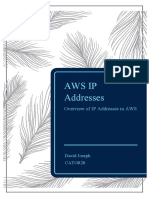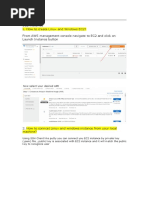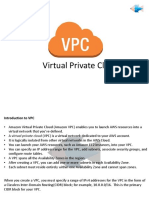0 ratings0% found this document useful (0 votes)
23 viewsIP Adressses Use Cases
IP Adressses Use Cases
Uploaded by
Chaitnya 4achieversAWS uses both public and private IP addresses to enable communication between EC2 instances within a VPC and with the internet. Elastic IP addresses provide a static public IP that can be remapped between instances, while instances are assigned public or private IP addresses depending on the subnet. Private IP addresses allow internal communication and remain until an instance is stopped, while public IPs are dynamic by default but can be made static with an Elastic IP. VPC and subnet CIDR blocks define the overall IP address space and ranges available for instances.
Copyright:
© All Rights Reserved
Available Formats
Download as DOCX, PDF, TXT or read online from Scribd
IP Adressses Use Cases
IP Adressses Use Cases
Uploaded by
Chaitnya 4achievers0 ratings0% found this document useful (0 votes)
23 views2 pagesAWS uses both public and private IP addresses to enable communication between EC2 instances within a VPC and with the internet. Elastic IP addresses provide a static public IP that can be remapped between instances, while instances are assigned public or private IP addresses depending on the subnet. Private IP addresses allow internal communication and remain until an instance is stopped, while public IPs are dynamic by default but can be made static with an Elastic IP. VPC and subnet CIDR blocks define the overall IP address space and ranges available for instances.
Original Title
IP adressses use cases
Copyright
© © All Rights Reserved
Available Formats
DOCX, PDF, TXT or read online from Scribd
Share this document
Did you find this document useful?
Is this content inappropriate?
AWS uses both public and private IP addresses to enable communication between EC2 instances within a VPC and with the internet. Elastic IP addresses provide a static public IP that can be remapped between instances, while instances are assigned public or private IP addresses depending on the subnet. Private IP addresses allow internal communication and remain until an instance is stopped, while public IPs are dynamic by default but can be made static with an Elastic IP. VPC and subnet CIDR blocks define the overall IP address space and ranges available for instances.
Copyright:
© All Rights Reserved
Available Formats
Download as DOCX, PDF, TXT or read online from Scribd
Download as docx, pdf, or txt
0 ratings0% found this document useful (0 votes)
23 views2 pagesIP Adressses Use Cases
IP Adressses Use Cases
Uploaded by
Chaitnya 4achieversAWS uses both public and private IP addresses to enable communication between EC2 instances within a VPC and with the internet. Elastic IP addresses provide a static public IP that can be remapped between instances, while instances are assigned public or private IP addresses depending on the subnet. Private IP addresses allow internal communication and remain until an instance is stopped, while public IPs are dynamic by default but can be made static with an Elastic IP. VPC and subnet CIDR blocks define the overall IP address space and ranges available for instances.
Copyright:
© All Rights Reserved
Available Formats
Download as DOCX, PDF, TXT or read online from Scribd
Download as docx, pdf, or txt
You are on page 1of 2
In AWS (Amazon Web Services), IP addresses work similarly to IP addresses
in traditional networking, but with some additional features and
management options specific to the AWS environment. Here are some key
aspects of how IP addresses work in AWS:
1. Elastic IP Addresses (EIP): In AWS, you have the option to allocate
an Elastic IP address to your instances. An Elastic IP address is a static,
public IPv4 address that you can associate with your AWS account
and remap to different instances within the same region. This
provides a fixed public IP address for your resources, even if you stop
or terminate an instance.
2. Public IP Addresses: When you launch an EC2 instance in a public
subnet, it is automatically assigned a public IP address by default.
This allows the instance to communicate with the internet directly.
The public IP address is dynamic and can change if you stop and
restart the instance. However, you can use an Elastic IP address to
provide a fixed public IP for instances that need a stable public
address.
3. Private IP Addresses: Each EC2 instance launched in a VPC is
assigned a private IP address from the IP address range defined for
the VPC's subnet. Private IP addresses are used for internal
communication between instances within the VPC and are not
accessible from the internet directly. Private IP addresses remain
unchanged unless you stop and restart the instance.
4. VPC CIDR Block: When you create a VPC, you define an IP address
range for the entire VPC. This IP address range is known as the VPC
CIDR (Classless Inter-Domain Routing) block. It determines the range
of IP addresses available for the instances and resources within the
VPC. For example, a common VPC CIDR block is "10.0.0.0/16," which
allows for up to 65,536 IP addresses.
5. Subnet CIDR Blocks: Within a VPC, you create subnets, each with its
own IP address range, known as the subnet CIDR block. Subnets are
logical segments of the VPC that allow you to organize resources and
control traffic flow. Instances launched in a subnet are assigned IP
addresses from that subnet's CIDR block.
6. NAT Gateway and NAT Instances: When instances in private
subnets need to access the internet for updates or to download
software, they use Network Address Translation (NAT) to
communicate through a public subnet with a public IP. AWS provides
NAT Gateway and NAT Instances for this purpose.
7. IPv6 Support: AWS also supports IPv6, and you can enable IPv6 for
your VPC and subnets if needed. IPv6 provides a large address space
and is becoming increasingly important as IPv4 addresses become
scarce.
Overall, IP addresses in AWS play a crucial role in enabling communication
between instances, both within the VPC and with the internet. Elastic IP
addresses offer flexibility and stability for public-facing resources, while
private IP addresses facilitate secure internal communication within the
VPC. The VPC CIDR block and subnet CIDR blocks define the overall IP
address space available to your resources, and proper planning is essential
to ensure efficient use of IP addresses within your AWS environment.
You might also like
- AWS Academy Cloud Foundations Module 05 Student Guide: 100-ACCLFO-20-EN-SGDocument79 pagesAWS Academy Cloud Foundations Module 05 Student Guide: 100-ACCLFO-20-EN-SGperbankan100% (2)
- Gixxer250 Naked-2021Document91 pagesGixxer250 Naked-2021juan pablo resrepo nieto100% (3)
- AWS Interview 250 QuestionsDocument34 pagesAWS Interview 250 Questionssrinubasani100% (1)
- AWS Solution Architect Class NotesDocument22 pagesAWS Solution Architect Class Notesnimitjn100% (2)
- CheatSheets - Google - Professional ArchitectDocument48 pagesCheatSheets - Google - Professional Architectdevop journeyNo ratings yet
- AWS Interview QuestionsDocument37 pagesAWS Interview Questionsinfo info80% (10)
- AZ 104T00A ENU PowerPoint - 04Document36 pagesAZ 104T00A ENU PowerPoint - 04Prakash Ray100% (1)
- Advertising and Promotion: An Integrated Marketing Communications PerspectiveDocument12 pagesAdvertising and Promotion: An Integrated Marketing Communications Perspectivedawgshit100% (1)
- Sponsorship ProposalDocument10 pagesSponsorship ProposalSumit GudkaNo ratings yet
- Gelfand - Lectures On Linear AlgebraDocument193 pagesGelfand - Lectures On Linear AlgebraVT Wyee100% (8)
- VPC (Virtual Private Cloud)Document11 pagesVPC (Virtual Private Cloud)skNo ratings yet
- Top 20 Aws InterviewquestionsDocument21 pagesTop 20 Aws InterviewquestionsZubair AhmadNo ratings yet
- IP Addresses in AWSDocument3 pagesIP Addresses in AWSDavid JosephNo ratings yet
- AWS Networking and Content DeliveryDocument7 pagesAWS Networking and Content Deliveryim.second007No ratings yet
- AWS PerpetrationDocument17 pagesAWS PerpetrationDibyajyoti DasNo ratings yet
- AWS FAQsDocument23 pagesAWS FAQsK213803 Ahsan NadeemNo ratings yet
- Aws VPC-1Document36 pagesAws VPC-1jyothibgNo ratings yet
- Amazon Web Services (VPC)Document14 pagesAmazon Web Services (VPC)mjfinanceatozNo ratings yet
- AWS - Interview Q & ADocument8 pagesAWS - Interview Q & Aumaprutuja740No ratings yet
- MasterDocument5 pagesMasterManoj KumarNo ratings yet
- Aws VPCDocument30 pagesAws VPCjyotiraditya0709.be21No ratings yet
- Get The Most, From The Best!!Document48 pagesGet The Most, From The Best!!Mangesh AbnaveNo ratings yet
- Amazon Elastic Container Service (ECS) Is A Highly Scalable, High Performance ContainerDocument8 pagesAmazon Elastic Container Service (ECS) Is A Highly Scalable, High Performance Containerrohanrajsn1208No ratings yet
- Azure Virtual NetworkDocument11 pagesAzure Virtual Networktrinitycloud001No ratings yet
- Amazon Virtual Private Cloud (Amazon VPC)Document11 pagesAmazon Virtual Private Cloud (Amazon VPC)Rajeev JhaNo ratings yet
- VPC Page 1Document6 pagesVPC Page 1sachin jainNo ratings yet
- Networking FaqDocument901 pagesNetworking Faqgx zoliNo ratings yet
- Module4 VirtualnetworkingDocument33 pagesModule4 VirtualnetworkingNithin krishnaNo ratings yet
- AWS Solution Architect Associate Exam NotesDocument80 pagesAWS Solution Architect Associate Exam NotesSandy LinNo ratings yet
- handson vpcDocument24 pageshandson vpcvaishbhat19No ratings yet
- Aws VPCDocument17 pagesAws VPCravi_kishore21100% (1)
- VPC AWsDocument51 pagesVPC AWsbraNo ratings yet
- Amazon Web Services Interview QuestionsDocument16 pagesAmazon Web Services Interview QuestionsMeenakshi RavikumarNo ratings yet
- Planet WebDocument30 pagesPlanet Webrosemoses765No ratings yet
- Get To Know More About AWS Virtual Private CloudDocument3 pagesGet To Know More About AWS Virtual Private CloudfoghornconsultingNo ratings yet
- Virtual Private Cloud (VPC) : by Bhupinder RajputDocument17 pagesVirtual Private Cloud (VPC) : by Bhupinder RajputCSCKUJAPI NITYAMNo ratings yet
- Azure - Az700 - Network EngineerDocument284 pagesAzure - Az700 - Network EngineerArdit ValljaNo ratings yet
- CVP StudyDocument10 pagesCVP Studyrramses.zamudioNo ratings yet
- What Is Amazon VPC?: VPC Providing A Certain Level of Isolation Between The Different Organizations Using The ResourcesDocument3 pagesWhat Is Amazon VPC?: VPC Providing A Certain Level of Isolation Between The Different Organizations Using The ResourcesSreekar Varma100% (1)
- Virtual Private Cloud (Amazon VPC) : Naresh I Technologies Amazon Web Services Avinash Reddy TDocument33 pagesVirtual Private Cloud (Amazon VPC) : Naresh I Technologies Amazon Web Services Avinash Reddy Tma3gr8No ratings yet
- Azure Stack Integration Into The Corporate NetworkDocument14 pagesAzure Stack Integration Into The Corporate NetworkJaouad ALLALINo ratings yet
- Lesson 4 AWS NetworkingDocument52 pagesLesson 4 AWS Networkingshiva.1912No ratings yet
- Az 700Document323 pagesAz 700Thilina Android100% (1)
- Top 50 AWS Interview Questions & AnswersDocument10 pagesTop 50 AWS Interview Questions & Answersshashi40410No ratings yet
- 1. Hosting the Server on AWSDocument5 pages1. Hosting the Server on AWSkah23604No ratings yet
- Amazon VPC Best PracticesDocument4 pagesAmazon VPC Best PracticesMadhu PNo ratings yet
- AWS Complete Notes For Beginners 1732013231Document21 pagesAWS Complete Notes For Beginners 1732013231rwptwgq7zdNo ratings yet
- File GatewayDocument38 pagesFile Gatewayrohanrajsn1208No ratings yet
- Module 7 - Virtual Private Cloud (VPC)Document16 pagesModule 7 - Virtual Private Cloud (VPC)Srinivas BathulaNo ratings yet
- Address INGDocument30 pagesAddress INGDawey GianeNo ratings yet
- Aws VPCDocument3 pagesAws VPCSam MccallNo ratings yet
- 01 Explore Azure Virtual NetworksDocument5 pages01 Explore Azure Virtual NetworksMuhammadSandyWirawanNo ratings yet
- Introduction To Amazon VPCDocument20 pagesIntroduction To Amazon VPCrosemoses765No ratings yet
- Comprehensive Guide to AWS Virtual Private Cloud (VPC)Document19 pagesComprehensive Guide to AWS Virtual Private Cloud (VPC)sureshNo ratings yet
- Top 50 AWS VPC Interview Questions and Answers - 2023Document24 pagesTop 50 AWS VPC Interview Questions and Answers - 2023jgovindaraajNo ratings yet
- How Grid Computing Differs From Cloud Computing? Justify What The Provisioning and Multi-Tenancy Properties of Cloud Computing Means?Document5 pagesHow Grid Computing Differs From Cloud Computing? Justify What The Provisioning and Multi-Tenancy Properties of Cloud Computing Means?JUNU CHAULAGAINNo ratings yet
- Cloud Computing 2071 by RK-8652Document5 pagesCloud Computing 2071 by RK-8652Markib Singh AdawitahkNo ratings yet
- Cisco Enterprise ProjectDocument15 pagesCisco Enterprise ProjectAfrin Akter Mim 191-15-12862No ratings yet
- AWS Practice QuestionsDocument17 pagesAWS Practice QuestionsSanjayNo ratings yet
- 11-AWS Compute, Storage and Network Services-20-08-2024Document24 pages11-AWS Compute, Storage and Network Services-20-08-2024pritish.kheraNo ratings yet
- Module 4Document74 pagesModule 4sharifNo ratings yet
- mod2notesDocument6 pagesmod2notesvaishbhat19No ratings yet
- We Asked The Project Management Community: What Steps Do You Take To Identify and Prioritize All StaDocument1 pageWe Asked The Project Management Community: What Steps Do You Take To Identify and Prioritize All StaBelishaNo ratings yet
- Faq Read Me PLS!!!!Document2 pagesFaq Read Me PLS!!!!ZuleNo ratings yet
- Email WritingDocument10 pagesEmail WritingPhạm Thị Ánh HằngNo ratings yet
- 18-19 Unit 5 Student OrganizerDocument4 pages18-19 Unit 5 Student OrganizerkristinNo ratings yet
- Reading ListDocument3 pagesReading ListMagali EsquivelNo ratings yet
- Tale 2 AssaignmentDocument24 pagesTale 2 AssaignmentblessyNo ratings yet
- WRC-510-2006 240812 134320Document63 pagesWRC-510-2006 240812 134320Kirubhakar.pNo ratings yet
- Vaidyshree Scheme - 2024Document5 pagesVaidyshree Scheme - 2024Mallikarjun IndiNo ratings yet
- Final Exam Fem2310 Sem 2 2021 2022 - LatestDocument2 pagesFinal Exam Fem2310 Sem 2 2021 2022 - Latest彭斌豪No ratings yet
- CodeDocument16 pagesCodeNamok HernandezNo ratings yet
- CihesionDocument11 pagesCihesioncristian tito ronaldoNo ratings yet
- Like The SunDocument5 pagesLike The Sunleena saNo ratings yet
- Aristophanes 1 - Clouds, Wasps, BirdsDocument459 pagesAristophanes 1 - Clouds, Wasps, Birdsmesame semestriNo ratings yet
- Healthy Food Start at Home - FAM Organic (Yg Benar)Document4 pagesHealthy Food Start at Home - FAM Organic (Yg Benar)shantyelisabetNo ratings yet
- Surgery SSKMDocument10 pagesSurgery SSKMYT ShortsNo ratings yet
- Lighting - Fire Starting & CandlesDocument78 pagesLighting - Fire Starting & CandlesThe 18th Century Material Culture Resource Center96% (28)
- Labour Activation Programme (LAP) Booklet 2022Document12 pagesLabour Activation Programme (LAP) Booklet 2022Khumbelo TshiololiNo ratings yet
- Technopreneurship 101Document5 pagesTechnopreneurship 101kristianronan.santiago.cvtNo ratings yet
- English Step by StepDocument1 pageEnglish Step by StepdaskentsalienkoNo ratings yet
- Irr Ra 10172Document7 pagesIrr Ra 10172Chariz FaustinoNo ratings yet
- Curriculum Alignment EngDocument23 pagesCurriculum Alignment EngrlaprietoNo ratings yet
- Catalog - 8FD-8FG Toyota Engine ForkliftDocument8 pagesCatalog - 8FD-8FG Toyota Engine ForkliftKen WalschNo ratings yet
- Higher Education and Muslims in India: Challenges and ProspectsDocument7 pagesHigher Education and Muslims in India: Challenges and ProspectsLeesa ShamimNo ratings yet
- Summary of IAS 8Document1 pageSummary of IAS 8Tin BatacNo ratings yet
- Acid Slurry Test MethodsDocument30 pagesAcid Slurry Test MethodswilmarlabacNo ratings yet
- World of Slide Guitar: Featuring John Fahey, Bob Brozman. Mike Auldridge Martin Simpson Debashish BhattacharyaDocument22 pagesWorld of Slide Guitar: Featuring John Fahey, Bob Brozman. Mike Auldridge Martin Simpson Debashish BhattacharyaCristhiams ParejaNo ratings yet

























































































